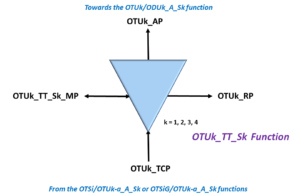What is an Atomic Function for OTN Applications?
If you have read through many of the ITU standards, particularly those documents that discuss the declaration and clearance of defect conditions, you have come across Atomic Functions.
For OTN applications, ITU-T G.798 is the primary standard that defines and describes defect conditions.
If you want to be able to read through ITU-T G.798 and have any chance of understanding that standard, then you will need to understand what these atomic functions are.
I will tell you that you will have a tough time understanding ITU-T G.798 without understanding these atomic functions.
Therefore, to assist you with this, I will dedicate numerous blog postings to explain and define many of these atomic functions for you.
NOTE: I also cover these Atomic Functions extensively in Lesson 8 within THE BEST DARN OTN TRAINING PRESENTATION…PERIOD!!!
OK, So What are these Atomic Functions?
You can think of these atomic functions as blocks of circuitry that do certain things, like pass traffic, compute and insert overhead fields, check for, and declare or clear defects, etc.
These atomic functions are theoretical electrical or optical circuits. They have their own I/O, and ITU specifies each function’s functional architecture and behavior.
It is indeed possible that a Semiconductor Chip Vendor or System Manufacturer could make products that exactly match ITU’s descriptions for these atomic functions. However, no Semiconductor Chip Vendor nor System Manufacturer does this. Nor does ITU require this.
ITU has defined these Atomic Functions such that anyone can judiciously connect a number of them to create an Optical Network Product, such as an OTN Framer or Transceiver.
However, if you were to go onto Google and search for any (for example) OTUk_TT_Sk chips or systems on the marketplace, you will not find any. But that’s fine. ITU does not require that people designing and manufacturing OTN Equipment make chips with these same names nor have the same I/O as these Atomic Functions.
OK, So Why bother with these Atomic Functions?
The System Designer is not required to design a (for example) OTUk_TT_Sk function chip. They are NOT required to develop chips with the same I/O (for Traffic Data, System Management, etc.).
However, if you were to design and build networking equipment that handles OTN traffic, you are required to perform the functions that ITU specified for these atomic functions.
For example, if you design a line card that receives an OTUk signal and performs the following functions on this signal.
- Checks for defects and declare and clear them as appropriate, and
- Monitors the OTUk signal for bit errors and
- Converts this OTUk signal into an ODUk signal for further processing
Although you are NOT required to have OTUk_TT_Sk and OTUk/ODUk_A_Sk atomic function chips sitting on your line card, you are required to support all of the ITU functionality defined for those functional blocks.
Therefore, you must understand the following:
- Which atomic functions apply to your system (or chip) design, and
- What are the requirements associated with each of these applicable atomic functions?
If you understand both of these items, you fully understand the Performance Monitoring requirements for your OTN system or chip.
What type of Atomic Functions does ITU-T G.798 define?
ITU-T G.798 defines two basic types of Atomic Functions:
- Adaptation Functions and
- Trail Termination Functions
I will briefly describe each of these types of Atomic Functions below.
Adaptation Functions
Adaptation Functions are responsible for terminating a signal at a particular OTN or network layer and then converting that signal into another OTN or network layer.
For example, an Adaptation function that we discuss in another post is a function that converts an ODUk signal into an OTUk signal (e.g., the OTUk/ODUk_A_So function).
Whenever you read about atomic functions (in ITU-T G.798), you can also tell that you are dealing with an Adaptation atomic function if you see the upper-case letter A within its name.
For example, I have listed some Adaptation functions that we will discuss within this blog below.
- OTSi/OTUk-a_A_So – The OTSi to OTUk Adaptation Source Function with FEC (for OTU1 and OTU2 Applications)
- OTSi/OTUk-a_A_Sk – The OTSi to OTUk Adaptation Sink Function with FEC (for OTU1 and OTU2 Applications)
- OTSiG/OTUk-a_A_So – The OTSiG to OTUk Adaptation Source Function with FEC (for OTU3 and OTU4 Applications)
- OTSiG/OTUk-a_A_Sk – The OTSiG to OTUk Adaptation Source Function with FEC (for OTU3 and OTU4 Applications)
- OTUk/ODUk_A_So – The OTUk to ODUk Adaptation Source Function
- OTUk/ODUk_A_Sk – The OTUk to ODUk Adaptation Sink Function
- ODUkP/ODUj-21_A_So – The ODUkP to ODUj Multiplexer Source Atomic Function
- ODUkP/ODUj-21_A_Sk – The ODUkP to ODUj Multiplexer Sink Atomic Function
Another Way to Identify an Adaptation Function?
ITU in general (and indeed in ITU-T G.798) will identify the Adaptation Function with trapezoidal-shaped blocks, as shown below in Figure 1.

Figure 1, A Simple Illustration of an Adaptation Function (per ITU-T G.798)
Now that we’ve briefly introduced you to Adaptation Functions let’s move on to Trail Termination Functions.
Clueless about OTN? We Can Help!!! Click on the Banner Below to Learn More!!!
Corporate Discounts Available!!!

Trail-Termination Functions
Trail Termination functions are typically responsible for monitoring the quality of a signal as it travels from one reference point (where something called the Trail Termination Source function resides) to another reference point (where another thing is called the Trail Termination Sink function lies).
When you read about atomic functions (in ITU-T G.798), you can also tell that you are dealing with a Trail Termination atomic function if you see the upper-case letters TT within its name.
The Trail Termination functions allow us to declare/clear defects and flag/count bit errors.
I’ve listed some of the Atomic Trail-Termination Functions we will discuss in this blog below.
- OTUk_TT_So – The OTUk Trail Termination Source Function
- OTUk_TT_Sk – The OTUk Trail Termination Sink Function
- ODUP_TT_So – The ODUk Trail Termination Source Function (Path)
- ODUP_TT_Sk – The ODUk Trail Termination Sink Function (Path)
- ODUT_TT_So – The ODUk Trail Termination Source Function (TCM)
- ODUT_TT_Sk – The ODUk Trail Termination Sink Function (TCM)
Another way to Identify a Trail-Termination Function?
In general (and indeed in ITU-T G.798), ITU will identify Trail Termination Function with triangular-shaped blocks. I show an example of a drawing with a Trail-Termination below in Figure 2.

Figure 2, A Simple Illustration of a Trail Termination Function (per ITU-T G.798)
We will discuss these atomic functions in greater detail in other posts.
Has Inflation got You Down? Our Price Discounts Can Help You Beat Inflation and Help You to Become an Expert on OTN!!! Click on the Banner Below to Learn More!!
Discounts Available for a Short Time!!

For More Information on OTN Posts in this Blog, click on the Image below.

OTN Related Topics within this Blog General Topics Consequent Equations - What are they and How can you use them? ...








